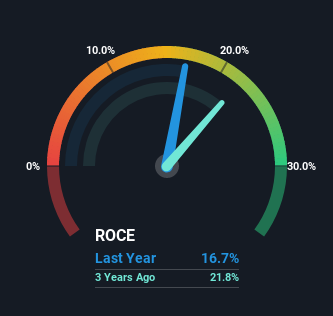- India
- /
- Electronic Equipment and Components
- /
- NSEI:DLINKINDIA
We Like These Underlying Return On Capital Trends At D-Link (India) (NSE:DLINKINDIA)
Did you know there are some financial metrics that can provide clues of a potential multi-bagger? Firstly, we'd want to identify a growing return on capital employed (ROCE) and then alongside that, an ever-increasing base of capital employed. Ultimately, this demonstrates that it's a business that is reinvesting profits at increasing rates of return. With that in mind, we've noticed some promising trends at D-Link (India) (NSE:DLINKINDIA) so let's look a bit deeper.
What is Return On Capital Employed (ROCE)?
For those who don't know, ROCE is a measure of a company's yearly pre-tax profit (its return), relative to the capital employed in the business. The formula for this calculation on D-Link (India) is:
Return on Capital Employed = Earnings Before Interest and Tax (EBIT) ÷ (Total Assets - Current Liabilities)
0.17 = ₹508m ÷ (₹5.1b - ₹2.1b) (Based on the trailing twelve months to March 2022).
Thus, D-Link (India) has an ROCE of 17%. In absolute terms, that's a satisfactory return, but compared to the Electronic industry average of 10% it's much better.
Check out our latest analysis for D-Link (India)

While the past is not representative of the future, it can be helpful to know how a company has performed historically, which is why we have this chart above. If you'd like to look at how D-Link (India) has performed in the past in other metrics, you can view this free graph of past earnings, revenue and cash flow.
What Can We Tell From D-Link (India)'s ROCE Trend?
Investors would be pleased with what's happening at D-Link (India). The data shows that returns on capital have increased substantially over the last five years to 17%. The amount of capital employed has increased too, by 74%. The increasing returns on a growing amount of capital is common amongst multi-baggers and that's why we're impressed.
On a separate but related note, it's important to know that D-Link (India) has a current liabilities to total assets ratio of 41%, which we'd consider pretty high. This can bring about some risks because the company is basically operating with a rather large reliance on its suppliers or other sorts of short-term creditors. Ideally we'd like to see this reduce as that would mean fewer obligations bearing risks.
Our Take On D-Link (India)'s ROCE
In summary, it's great to see that D-Link (India) can compound returns by consistently reinvesting capital at increasing rates of return, because these are some of the key ingredients of those highly sought after multi-baggers. Since the total return from the stock has been almost flat over the last five years, there might be an opportunity here if the valuation looks good. That being the case, research into the company's current valuation metrics and future prospects seems fitting.
If you want to continue researching D-Link (India), you might be interested to know about the 3 warning signs that our analysis has discovered.
While D-Link (India) isn't earning the highest return, check out this free list of companies that are earning high returns on equity with solid balance sheets.
New: Manage All Your Stock Portfolios in One Place
We've created the ultimate portfolio companion for stock investors, and it's free.
• Connect an unlimited number of Portfolios and see your total in one currency
• Be alerted to new Warning Signs or Risks via email or mobile
• Track the Fair Value of your stocks
Have feedback on this article? Concerned about the content? Get in touch with us directly. Alternatively, email editorial-team (at) simplywallst.com.
This article by Simply Wall St is general in nature. We provide commentary based on historical data and analyst forecasts only using an unbiased methodology and our articles are not intended to be financial advice. It does not constitute a recommendation to buy or sell any stock, and does not take account of your objectives, or your financial situation. We aim to bring you long-term focused analysis driven by fundamental data. Note that our analysis may not factor in the latest price-sensitive company announcements or qualitative material. Simply Wall St has no position in any stocks mentioned.
About NSEI:DLINKINDIA
D-Link (India)
Engages in the marketing and distribution of D-Link branded networking products for consumers, small businesses, medium to large-sized enterprises, and service providers in India.
Flawless balance sheet established dividend payer.
Similar Companies
Market Insights
Community Narratives


Recently Updated Narratives

Constellation Energy Dividends and Growth

CoreWeave's Revenue Expected to Rocket 77.88% in 5-Year Forecast

Bisalloy Steel Group will shine with a projected profit margin increase of 12.8%
Popular Narratives


MicroVision will explode future revenue by 380.37% with a vision towards success


NVDA: Expanding AI Demand Will Drive Major Data Center Investments Through 2026



